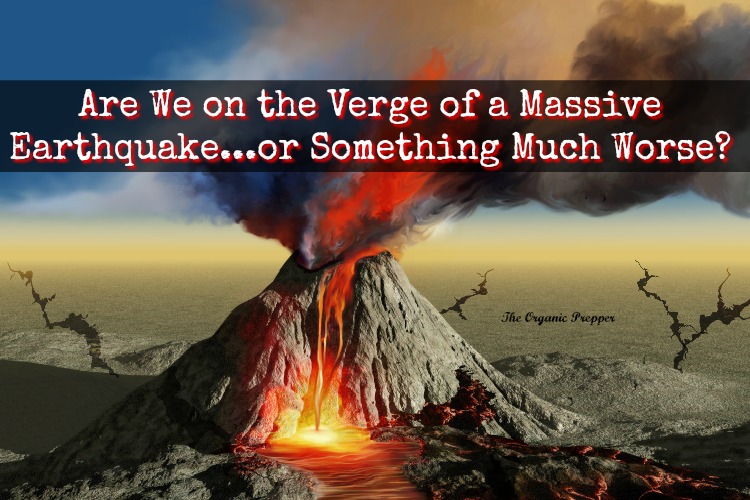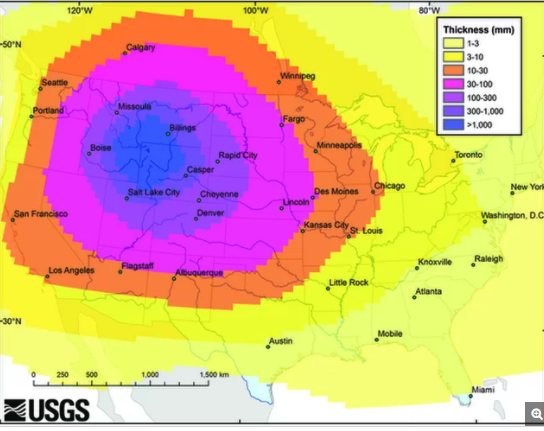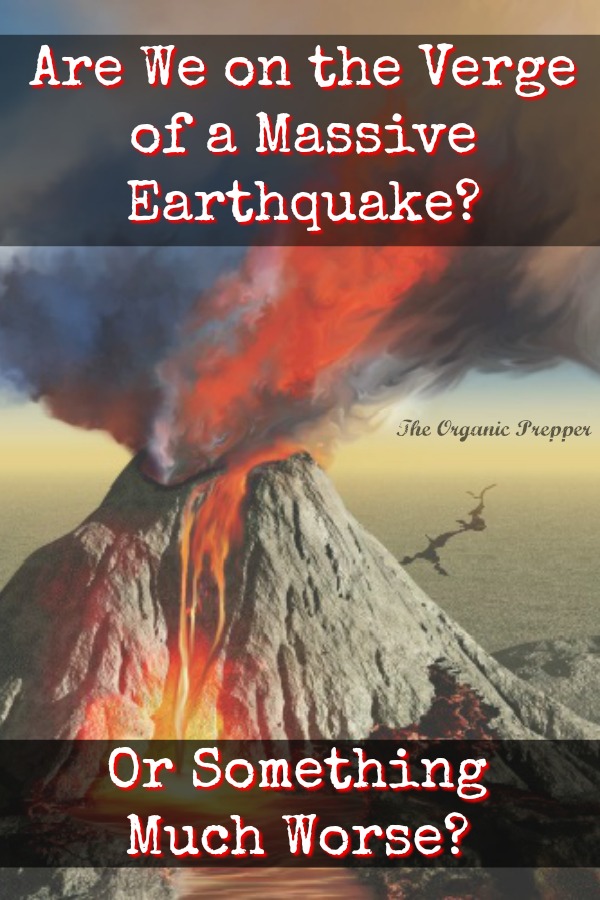If you're new here, you may want to subscribe to my RSS feed. Thanks for visiting!
By Daisy Luther
UPDATE, June 28, 2016: Two weeks after I originally wrote this article, the shaking hasn’t stopped. The ticker is now up to 878 earthquakes in Yellowstone Park. Fortunately, scientists say there is no sign of pending eruption from the volcano at this time.
Jacob Lowenstein, one of the USGS scientists in charge of monitoring the Yellowstone Volcano said:
For magma to reach the surface, a new vent needs to be created, which requires a lot of intense geological activity.
“The volcano alert level remains at green. As outlined in our response plan, USGS Circular 1351, we would need to see considerably more and larger earthquakes, combined with contemporaneous ground deformation, steam explosions, and changes in gas and heat discharge prior to moving the alert level. None of that has occurred.”
Of course, this doesn’t permanently negate our concern about the massive pool of magma simmering underneath the park. The risks of an eruption described in this article are very real. But people can breathe a little easier. For now.
A strong uptick in seismic activities in two places in the United States has experts concerned about the possibility of a massive earthquake…or something exponentially worse – the potential eruption of the Yellowstone Supervolcano.
The pressure in the San Andreas Fault is increasing.
Mac Slavo wrote about the warning signs at the San Andreas fault, 100 miles outside of Los Angeles.
A study published earlier this year concluded that the land on either side of the San Andreas fault has been pushing against the other at a rate of more than 1 inch per year since 1857, and the tensions between the plates are eventually going to give out.
“So, you expect that amount of accumulation of energy will be released in the future in a large-magnitude rupture, somewhere along the San Andreas,” said USGS research geologist and study lead author Kate Scharer.
Seismologist Lucy Jones predicts that a San Andreas earthquake beginning at the Salton Sea could be as strong as an 8.2 if it got all the way to Paso Robles. That powerful of a quake could result in massive loss of life and damages. An 8.2 earthquake would produce far more energy than what was produced by the nuclear bomb dropped on Hiroshima. (source)
To make matters worse, it is possible this would not be an isolated incident. A quake along the San Andreas fault could trigger a quake along the Hayward fault, which goes right through the highly populated San Francisco Bay area.
But as awful as that scenario sounds, we could have even bigger problems.
There have been hundreds of earthquakes in Yellowstone this week.
A swarm of earthquakes in iconic Yellowstone Park has scientists on alert. The US Geological Survey has reported nearly 300 quakes since last Monday. By themselves, this would not be incredibly worrisome.
But anyone who has ever driven through Yellowstone and witnessed the natural thermal activity throughout the park becomes fully aware that they’re driving over a massive pocket of molten lava…a supervolcano. This video explains exactly what lies under Yellowstone National Park.
What would happen in the event of an eruption?
Michael Snyder of the website, The End of the American Dream, paints a chilling picture of what an eruption of the Yellowstone Volcano would look like:
Hundreds of cubic miles of ash, rock and lava would be blasted into the atmosphere, and this would likely plunge much of the northern hemisphere into several days of complete darkness. Virtually everything within 100 miles of Yellowstone would be immediately killed, but a much more cruel fate would befall those that live in major cities outside of the immediate blast zone such as Salt Lake City and Denver.
Hot volcanic ash, rock and dust would rain down on those cities literally for weeks. In the end, it would be extremely difficult for anyone living in those communities to survive. In fact, it has been estimated that 90 percent of all people living within 600 miles of Yellowstone would be killed.
Experts project that such an eruption would dump a layer of volcanic ash that is at least 10 feet deep up to 1,000 miles away, and approximately two-thirds of the United States would suddenly become uninhabitable. The volcanic ash would severely contaminate most of our water supplies, and growing food in the middle of the country would become next to impossible…
The rest of the planet, and this would especially be true for the northern hemisphere, would experience what is known as a “nuclear winter”. An extreme period of “global cooling” would take place, and temperatures around the world would fall by up to 20 degrees. Crops would fail all over the planet, and severe famine would sweep the globe.
In the end, billions could die. (source)
How do you even begin to prepare for an earthquake so massive?
The first thing you need to know is how to withstand the initial disaster. In the event of a massive earthquake, it depends whether you are indoors or outdoors what you should do. Go here to learn how to survive an earthquake.
Assuming you survive the quake, the aftermath can be every bit as dangerous. Your best bet is to get to a safe structure and remain there.
Aftershocks may be just as strong as the original earthquake, and in some cases, even weak aftershocks can cause further infrastructure damage to structures that have been weakened by the earlier seismic activity. So it’s important to note that even if your shelter is originally safe, you’ll need to reassess after subsequent quakes.
Expect that emergency services such as police, fire, and ambulances will be unavailable. You will be on your own with only the supplies that you have available to you. Utilities will almost certainly be interrupted and there is a high risk of fire after a massive earthquake. If the water is still running, there is a high likelihood that it will be tainted. You should have the supplies on hand to hunker down with your family for at least a month.
How do you prep for the eruption of a supervolcano?
This is much more difficult.
When considering the long-term affects of this, having as much food stockpiled as possible is essential. But for the purposes of this article, let’s talk about short-term survival and worry about the nuclear winter part later.
Cliff Montgomery from Secrets of Survival wrote about the eruption of Mount St. Helens back in 1980.
Shaken 10 minutes earlier by an earthquake measuring 5.1 on the Richter scale, the north face of this tall, symmetrical volcano collapsed, resulting in the largest known landslide in world history. These slabs of earth and ice slammed into nearby Spirit Lake, crossed a ridge 1,300 feet high, and roared 14 miles down the Toutle River.
The avalanche rapidly released pressurized gases that had long been surging inside the mountain. For at least a week its northwestern flank had been bulging out as much as 12 feet a day from the increasing pressure of rising magma.
And then Mount St. Helens – a pristine, previously dormant volcano that had long been a major part of the eastern Washington landscape – mostly ceased to exist.
The explosion was five hundred times more powerful than either of the atom bombs dropped on Hiroshima or Nagasaki.
The tremendous lateral blast turned 250 million cubic yards of mountain into a turbulent, stone-filled wind that swept over ridges, toppled trees and scorched the earth nearby at temperatures well over 600 degrees Fahrenheit, flattening or disintegrating practically everything within a 150 square miles of the volcano’s northern side.
Within minutes the eruption began blasting material straight up into the sky; it would continue for 9 hours. The top 1,317 feet of the peak and most of its northwestern side were no more. In its place would eventually be a gaping, horseshoe-shaped crater 2,460 feet deep, making St. Helens little more than a gargantuan shell.
The final result of this activity was a mushroom-shaped column of volcanic ash that rose thousands of feet skyward and drifted across eastern Washington and beyond, turning day into darkest night as gray ash fell over a major part of the southwest. Melted snow and earth became wet, cement-like slurries of rock and mud scouring all sides of the volcano. Searing flows of white-hot lava oozed from the gaping crater. (source)
(Definitely, check out this article. It continues and shares a story of first-hand survival about a logger who was far too close when the volcano erupted.)
And as horrific as this eruption was, it was tiny in comparison to an eruption of Yellowstone.
It’s entirely possible that a supervolcano would be unsurvivable, particularly for those within 600 miles. If you are in the outer part of that radius, have a plan to get in your car and drive in the opposite direction as fast as you can the moment you hear about the eruption. The wave of ash will take a while to spread to the outer parts of that circumference, and it will all depend on the winds how quickly it gets to you.
If you survive the initial eruption, your next concern will be ash.
Volcanic ash is superfine particles of rock. It’s essential to avoid breathing this into your lungs or getting it into your eyes. Your best bet is a gas mask, and your next best bet is an N100 mask with a particulate respirator. You can also stock a dual cartridge respirator (this one comes with goggles) like the kind that painters use. If all else fails, tying a bandana around your nose and mouth is better than nothing at all. Protect your eyes with snug-fitting safety goggles, or even swim goggles. (We keep swim goggles in our bug-out bags after living in a place prone to wildfires for 3 years.)
When you hunker down, you need to secure your home (or wherever you are) against the ash that will soon coat everything like a blizzard.
- Fill every possible container in your home with water before it gets tainted, including sinks and bathtubs.
- Close all ducts to the outside.
- Tape shut the edges of your windows.
- Place damp towels against the bottom of all exterior doors.
- Turn off central heat and air conditioning.
- If you have a fireplace or woodstove, close your dampers.
When the ash is no longer falling as thickly, you may need to go clear accumulated ash off your roof to keep it from collapsing. Wear your goggles and respirator, as well as full-length pants, long sleeves, and a hat. Remove this clothing at the door when you come back into your house.
While ash is falling, avoid running your vehicles. The sediment will clog up the engine and damage it, and you won’t be able to use your vehicle to evacuate later.
Many people would have to be evacuated outside of America.
Should Yellowstone erupt, it’s entirely likely that a large part of the United States would become uninhabitable. Our government has contracts with some countries in South America for this very reason.
Shepard Ambellas of Intellihub wrote:
The U.S. is currently under contract with at least 4 countries all of which have agreed to house displaced U.S. citizens in the unfortunate event the Yellowstone supervolcano were to erupt. Hundreds of billions of dollars were paid to foreign governments to facilitate the agreement which spans a ten year period from its signing, ending in 2024.
An excerpt from an article I authored in April of 2014 titled: “Report: Brazil, Argentina and Australia sign contracts worth hundreds of billions of dollars to house displaced U.S. populace when Yellowstone supervolcano erupts” reads:
The U.S. plan for relocation was formulated after a recent scientific analysis of the park revealed that Yellowstone’s supervolcano has the potential to violently erupt within the next 10-years as noted by others including the famous astrophysicist Michio Kaku… according to the report, “Brazil, Argentina and Australia” jumped on the bandwagon, accepting the request from Washington. (source)
How badly would your area be affected by an eruption of the Yellowstone Supervolcano?
Nearly the entire continental US would be affected to some degree by an eruption of the Yellowstone Supervolcano. The USGS speculates this is what the ashfall would look like a month after the eruption.
Live Science reports:
The ash would be pretty devastating for the United States, scientists predict. The fallout would include short-term destruction of Midwest agriculture, and rivers and streams would be clogged by gray muck.
People living in the Pacific Northwest might also be choking on Yellowstone’s fallout…
But California and Florida, which grow most of the country’s fruits and vegetables, would see only a dusting of ash…
Yellowstone Volcano’s next supereruption is likely to spew vast quantities of gases such as sulfur dioxide, which forms a sulfur aerosol that absorbs sunlight and reflects some of it back to space. The resulting climate cooling could last up to a decade. The temporary climate shift could alter rainfall patterns, and, along with severe frosts, cause widespread crop losses and famine. (source)
Like many disasters that seem as though they’d be extinction-level events, even this is survivable if you aren’t right in the middle of things when the initial eruption occurs.
But recent seismic activity should be a reminder that Mother Nature can throw a monkey wrench in our plans at any given moment.
We need to be prepared, because I strongly suspect, to paraphrase, “We ain’t seen nothin’, yet.”


















6 Responses
15 Nuclear Reactors on New Madrid Fault Line
Living in Kentucky, this is something I have thought about. If there was a major earthquake along the New Madrid fault line, it would do great damage.
Buildings are NOT built to earthquake code, as in California. A major earthquake would damage infrastructure, especially buildings, roads and especially bridges. Then, trucks and trains would not be able to transport goods, especially FOOD.
We have seen the damage an earthquake in Japan did to ONE reactor. Radiation from Fukushima is still spreading across the Pacific Ocean. If MULTIPLE nuclear reactors were affected by a large earthquake, great areas of land would not be suitable for farming for a LONG time.
Currently, about 2% of the population grows the food that feeds the other 98%. The last major earthquake on this fault line included the area known as the “breadbasket” of the country, where the great majority of the wheat and corn in the U.S is grown. (See map in article)
The east coast has a large population concentration extending up and down the Atlantic coast. Should food distribution be affected, soon after the large cities in the east (New York, Philadelphia, Boston, Baltimore, Washington, Atlanta, etc.) would experience food shortages. You would see a “golden horde” of people leaving the cities and heading to the country, where they believe there would be food.
https://www.sott.net/article/225939-15-Nuclear-Reactors-on-New-Madrid-Fault-Line
Even living nearly 2,000 miles away from the caldera, the reminder of the nuclear winter that would inevitably follow is unsettling. Carl Sagan co-wrote a great book about nuclear winter, titled A Path Where No Man Thought, but it mostly addresses nuclear weapons and not super volcanoes.
I did notice in one article about this that they said there was a 10% chance this would happen within the next 10 years. That means, conversely, there is a 90% chance it won’t happen.
And as far as California, I think they have been predicting The Big One, for about as long as I’ve been alive, almost 70 years now. Yeah, it will probably happen someday. So will the Second Coming of Christ, and I’m not sure which will come first.
I wonder if the countries to whom we paid hundreds of billions of dollars are even making the necessary preparations to clothe, house, and feed us when needed, or if they would even honor the agreement since we would be in a severely weakened state?
Due to several treaties held between Australia and the US, Australia would be highly likely to support the US. The only problem – Australians are generally just as anti-immigration as the US, meaning a lot of unhappy people. But don’t worry. 90% of Australians live on or near the coast, and Australia is roughly the same size as continental US, meaning there is millions of acres of empty land that could be developed into housing. But the whole nuclear winter would mean rationing, and the government might decide to take care of Australians first. And due to gun laws, US citizens are unlikely to be able to purchase firearms, as you need to be a citizen or a permanent resident of Australia to purchase a firearm. And I don’t think that the Australian government will be likely to want to give these displaced people permanent residency, as the government is very much so pro-Australia and less ‘let’s let more US citizens live here than the current population of Australia’. And so, with displaced US citizens getting less food and unable to hunt effectively (crossbows are also highly illegal), martial law and huge protests might happen. So, to recap, Australia will help (Yay!), but might not help lots due to a lack of resources (Ohh…), and might even treat displaced US citizens as second class (but probably won’t go all death camps, or even FEMA camps, as Australia doesn’t have FEMA). So don’t worry about Australia not helping, just worry about the amount of help that will be provided 🙂
I remember when Mt. St. Helen’s went off. I still live here in deep south Texas, and even so far away we got ash all over our cars within a couple of days. I hate to think what we might get from Yellowstone.